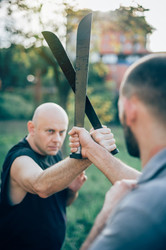Machetes – Versatile, Efficient Tools
20th Nov 2016
Machetes are unusual in that this blade can be used as a weapon and a shovel. Pinpointing its exact origin is difficult. What we do know is that the machete is a cutting and chopping tool used in agricultural and rural areas all over the world. The machete is popular in subtropical counties for its capacity to cut through rain forest undergrowth and its value as a farming implement (cutting sugarcane for instance). Splitting rock-hard coconuts, removing small branches and plants, clearing bushes are other jobs that the machete can do efficiently – the blade embodies versatility.
It has made quite a name historically and culturally as well. In 1762, when the British invaded Havana, the Cuban guerrillas used machetes in the defense of the city. A hundred years later, the machete was an iconic symbol in Cuba’s revolt against the Spanish government. In West Africa, the machete is still a popular sidearm for many ethnic groups. In movies, Jason Voorhees popularized it during the 1980s with the Friday the 13th series.

The Latin machete or the bush machete is the one immediately brought to mind when you hear the word “machete.” It has a plain look, straight back blade, is evenly weighted and stout. This effective utility tool is great for cutting vegetation.

The Kukri, a Nepalese knife with the inwardly curved edge, is among the most popular. Though not a machete per se, it is quite similar. The kukri is the standard weapon of the Nepalese Army, the Royal Gurkha Rifles, and all Gurkha regiments around the world. The blade’s three parts have distinct usage – the tip is useful in combat (for stabling), the broader midsection helps to chop, and the narrow area close to the handle is perfect for carving.

The Panga, also called tapanga, is a variation of the machete and is found commonly in East and Southern Africa. The backside of the blade is broad and the tool can reach a length of 18 inches. Traditionally, the Panga knife’s weight makes it ideal for chopping and its curvature enables easy slicing.

The Bolo closely resembles the Panga but is broader just before the tip which enables greater efficiency in chopping. These blades are popular in Filipino households for clearing vegetation and cutting food. The bolo makes for a terrific harvesting tool and has tremendous chopping power.The Parang is a shorter, stouter version of the Panga and Bolo, and is found in Indonesia and Malaysia. These are among the thickest machetes and perfect for cutting thick foliage without the fear of the blade getting stuck in the vegetation. Then there is the Golok machete, similar to the Parang in looks and usage, which originated in Southeast Asia.We suggest that you buy these blades from authentic, reliable stores. If you want to buy machetes online, Atlanta Cutlery has just the perfect collection for you.


 Gift Cards
Gift Cards